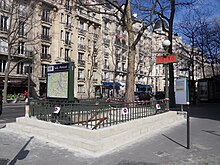Sully - Morland (Paris Metro)
|
|
|
|---|---|

|
|
| Tariff zone | 1 |
| Line (s) |
|
| place | Paris IV |
| opening | June 3, 1930 |
The subway station Sully - Morland is an underground station of Line 7 of the Paris Métro .
location
The station is located in the Quartier de l'Arsenal in the 4th arrondissement of Paris . It lies lengthways under the Quai des Célestins street before it joins the Boulevard Henri IV.
Surname
One of the namesake is the nearby Seine bridge Pont de Sully (also: Pont Sully), which leads across the island of Île Saint-Louis to the Rive Gauche . It was opened in 1877 and named after Maximilien de Béthune (1560–1641), Duke of Sully-sur-Loire . As royal finance minister (surintendant des finances) of Henry IV , he had made outstanding contributions to the country's economic development from 1598 onwards.
The second part of the name refers to the Boulevard Morland. François-Louis Morland (actually: François-Louis de Morlan; 1771-1805) was a French colonel who was seriously wounded in the Battle of Austerlitz and died three days later in Brno . His body was transferred to Paris in a barrel of rum and preserved as a mummy in the École de Médecine de Paris .
History and description
The station went into operation on June 3, 1930 under the name “Pont Sully” when the section of line 7 from Pont Marie was extended by one station. Until April 26, 1931, it was the southern terminus of line 7.
It was built with a length of 105 m, which is theoretically sufficient for seven-car trains. Under an elliptical , white-tiled ceiling vault, it has side platforms on two parallel tracks. Two entrances are on the east side of Boulevard Henri IV, on both sides of the junction with Rue de Sully, and a third on Rue du Petit Musc. They have illuminated station signs with a network map , the two northern ones also have a candelabra designed by Adolphe Dervaux in the Art Deco style with the word METRO. If there is a threat of flooding, the accesses are secured by a wall.
Immediately to the east of the station, the line makes a 90 ° curve and, after a ramp with a gradient of 40 ‰, crosses the Seine before the eastern tip of the Île Saint-Louis.
vehicles
Conventional five-car trains of the MF 77 series run on Line 7 . Between 1971 and 1979 trains of the MF 67 series ran there , before that of the Sprague-Thomson type .
Web links
literature
- Gérard Roland: Stations de métro. D'Abbesses à Wagram . 2003, ISBN 2-86253-307-6 .
Individual evidence
- ^ Gérard Roland: Stations de métro d'Abbesses à Wagram . Christine Bonneton, Clermont-Ferrand 2011, ISBN 978-2-86253-382-7 , pp. 202 .
- ^ Jean Tricoire: Un siècle de métro en 14 lignes. De Bienvenüe à Météor . 2nd Edition. La Vie du Rail, Paris 2000, ISBN 2-902808-87-9 , p. 225 .
- ^ Brian Hardy: Paris Metro Handbook . 3. Edition. Capital Transport Publishing, Harrow Weald 1999, ISBN 1-85414-212-7 , pp. 36 .
- ↑ Jean Tricoire: op. Cit. P. 74.
- ↑ Jean Tricoire: op. Cit. P. 227 and 245.
| Previous station | Paris metro | Next station |
|---|---|---|
|
Pont Marie ← La Courneuve - May 8, 1945 |
|
Jussieu Mairie d'Ivry or Villejuif - Louis Aragon → |
Coordinates: 48 ° 51 ′ 4 " N , 2 ° 21 ′ 45" E

